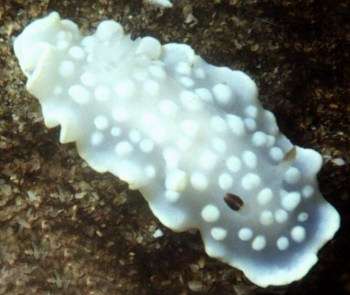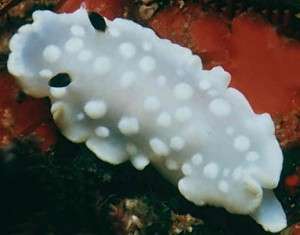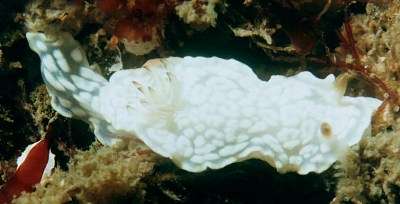

Glossodoris sp. 7.
Order: NUDIBRANCHIA
Suborder: DORIDINA
Superfamily: EUDORIDOIDEA
Family: Chromodorididae
PHOTO
South coast KwaZulu-Natal, South Africa.
UPPER: near Port Shepstone - 37m. Dec 1999. Size: 40mm. See message 1. LOWER: Park Rynie - 25m, 25mm See message 2
PHOTOS: Valda Fraser.
Until Valda Fraser's second message I had considered two white-spotted species she had sent photos of to be one species, which I called Glossodoris sp. 7.. After that I decided to split the two and have moved one of the colour forms to Glossodoris sp. 8. Without any anatomical information the placing of both in the genus Glossodoris is of course provisional. The main points of colour difference is that in Glossodoris sp. 7 the gills are white and the rhinophore clubs are very dark grey, while in Glossodoris sp. 8 the tip of the gills is edged in a dark brown and the upper half of the rhinophore clubs are also brownish, the basal half fading to translucent white. In Glossodoris sp. 7 the white spots on the mantle are distinctly raised rounded tubercles while in Glossodoris sp. 8 they are crowded and irregular, often elongate, in shape and also occur on the foot. In Glossodoris sp. 7 the foot seems to be auniform translucent white.
These species have similarities to two other white spotted species from South Africa, in the Forum: Glossodoris undaurum and Glossodoris cf tomsmithi, but there are differences in mantle colour, and in the colour of the gills and rhinophores.
See also Valda Fraser's message below.
Authorship detailsRudman, W.B., 2000 (April 23) Glossodoris sp. 7. [In] Sea Slug Forum. Australian Museum, Sydney. Available from http://www.seaslugforum.net/find/glossp7
Related messages
White-spotted Glossodoris from S.Africa.
May 29, 2000
From: Valda Fraser


Dear Bill
Before, you tentatively suggested that here we are dealing with one animal, i.e. Glossodoris sp. 7. The more I see these nudibranchs, the more I think they must be different. It's such a pity I can't drag you along to see for yourself!
UPPER: - Park Rynie - 25m, 25mm
Body: cylindrical shape with raised nodules
Foot: short and white
Rhinophores: dark
Gills: very pale
LOWER: - Aliwal Shoal, Umkomaas - 15m, 20mm
Body: cylindrical shape with indentation and nodules which stand out very slightly
Foot: long with same markings as the body
Rhinophores: white, tipped with greenish/brown
Gills: same colouring as rhinophores
What do you think?
Regards
Valda
iti04937@mweb.co.za
Fraser, V., 2000 (May 29) White-spotted Glossodoris from S.Africa.. [Message in] Sea Slug Forum. Australian Museum, Sydney. Available from http://www.seaslugforum.net/find/2378Dear Valda,
Your second photos clearly show the same differences as the first two. I know that's not a very big sample but knowing how important such differences are in many species I am more than happy to consider them to be distinct species. It would be nice to get some information on which sponges they feed on and what their egg masses look like. I have split them into Glossodoris sp. 7 and Glossodoris sp. 8.
Best wishes,
Bill.
Glossodoris species from South Africa
April 24, 2000
From: Valda Fraser


Dear Bill
This is a big puzzle for me. Are both images of the same nudibranch? I'm not sure because the one seems to have more pronounced nodules - including an irregular growth! It would be easier if we could see it's foot. I hope
you will be able to help.
Locality: South coast KwaZulu-Natal, South Africa, near Port Shepstone - 37m and 32m
Date: Dec 1999
Size: 40mm (upper) and 48mm (lower)
Regards
Valda Fraser
iti04937@mweb.co.za
Valda Fraser, V., 2000 (Apr 24) Glossodoris species from South Africa. [Message in] Sea Slug Forum. Australian Museum, Sydney. Available from http://www.seaslugforum.net/find/2281Dear Valda,
At the moment I think they are probably the same species. A character worth noting is the colour of the gills and the rhinophores. Sometimes two species almost identical in mantle colour can be distinguished on some detail of the rhinophore colour or the shape or colour of the gills. I notice the edges of the tips of the gills in the lower photo are lined with a dark colour not visible in the upper photo. Only more observations and a look at specimens will clarify the situation, but it is an example of how important it is to look for such differences. I'm glad that your seem to be developing a suspicious mind about such things.
I'm afraid I can't give this species a name other than Glossodoris sp. 7. It has similarities to two other white spotted species you have sent photos of ; Glossodoris undaurum and Glossodoris cf tomsmithi, but their are differences in mantle colour, and in the colour of the gills and rhinophores.
Can you clarify one thing for me please. In the photos there seems to be a tinge of yellow at the mantle edge. Is that so or am I imagining it?
Best wishes,
Bill Rudman.
